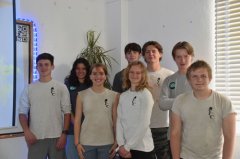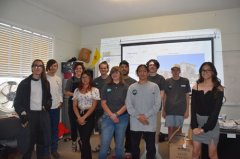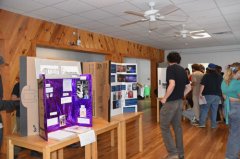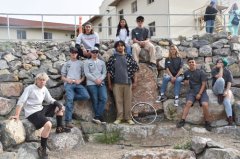Photos and article by Lynn Janes
Aldo Leopold Charter School internship showcase 050323
Aldo Leopold Charter School internship showcase 050323
Eco Monitoring Crew - Front left to right – Ethan Hemphill, Beth Jacobs, Minnie Metcalfe, Kevin Peterson; Back left to right – Phini Khera, Morgan Chaney, Aidan Finley, Kojun Iwaasa
Aldo Leopold Charter School internship showcase 050323
Garden Crew - Front left to right – Allen Trujillo, Angelica Sosaya, Emma Smith, Cesar Acosta, Perisha Rodriguez; Back left to right – Tru Ugarte, Sonata Baca, David Pecotte, Dominic Vega, Sebi Castello, Isaac Younger-Titus
Aldo Leopold Charter School internship showcase 050323
Individual internship displays
Aldo Leopold Charter School internship showcase 050323
Trial Crew - Front left to right – Kyuss Hogan, Parker Cox, Michael Marriage, Cisco Aguilar, Jessi Cocker, Junior Casaus, Kyra Floyd; Back left to right – Thomas Pendleton, Erika Murillo, Addi Pearson
On May 3, 2023, Aldo Leopold Charter School held the end of the semester showcase for the internships that some of the students participated in. The event took place at the school location on the Western New Mexico University campus in Ritch Hall located at 410 W. 10th Street.
Aldo Leopold started with the premise that many students learn best by doing and having direct experience. The school developed out of the community wanting to provide a choice to the area's students. The mission statement of the school, the human and natural environments, serve as a text and lab for learning through direct experience, inquiry, and stewardship.
Some of the students had done individual internships with different businesses in the area and had displays that explained the job, what they did, and what they learned.
The school also had four programs with the Youth Conservation Corp (YCC). YCC started during the depression in 1933 as a voluntary program. At that time the name had been Civilian Conservation Corps (CCC). The four programs Aldo Leopold has included the garden crew, mural crew, trail crew and eco-monitoring crew. Each crew prepared a slide presentation of what they had done and how it had enriched them. Each student also spoke about the experience and what they had learned.
The YCC program teaches the students what they call the four Cs. Each presentation they addressed the ways this had been used. The four Cs stood for Collaboration, Communication, Critical Thinking and Creativity. Each crew had used these principals to address everything they did to be successful with the projects.
The eco-monitoring crew worked on several projects and gathered data on the natural world. This year they used something new "I Naturalist" a data program that can be used nationwide to track the data put in from all over. One of the projects encompasses catching birds, banding them, taking information on that bird such as wingspan, weight, age, etc. which they input into I Naturalist. The students worked in cooperation with GRIP (Gila Information Resources Project) on erosion control and the removal of invasive species of plants in San Vicente Creek. A small dam had been part of that project to catch sediment and disperse water to help encourage more vegetation. They also worked at the old iron bridge near Cliff. They planted willow poles and tested water quality. The eco crew also has been monitoring the health of the Dragon Fly Trail. All the students commented on how much they learned and enjoyed their mentor Mike Fugagli leader of the eco-monitoring crew. The seniors in the group gave a separate presentation on what they would be doing after graduation and what career path they would pursue.
Patricia Hurley, owner of Lone Mountain Nature Nursery, served as the leader and mentor of the garden crew. Each student had said they learned a lot with her help. They had learned about pollination, garden maintenance and plant identification. Along with being able to identify plants they had learned what plants grew best in what environment. This year their projects included the Waterworks building area, Big Ditch, and the Aldo Leopold garden at the school. The projects included working on the soil to help the plants grow better, planted seedlings, restoration of gardens, and maintenance. One of the students talked about growing the seedling and named the plants she had watched grow. They have a greenhouse on the school grounds that had fallen into disrepair. The students did fundraising to purchase the materials to fix it. They also planted plants and trees in San Vicente Creek. The students commented on how they had used the 4 Cs to accomplish their projects. One said it had taught them a good work ethic and another said she had learned to appreciate the small things. One student had said they had been socially challenged but being on the crew had helped them with their social and communication skills and an appreciation of community work.
The trail crew went over how they had utilized the 4 Cs and how it had helped them do their project. The students had worked on the garden at the school. It sits on a steep hill so they made a trail and did rock work to stop erosion. The trail had been thought out to maximize the ability to be easy to walk and still stop any erosion. They had learned to use several different tools to accomplish their task. They showed each one in the slides and how they had used them. Toxtli Sanchez mentored the students for the project building the stone walkway and garden. Each one of the students said he had taught them how to work efficiently and safely. One student said it had been hard work but had learned a lot and how to work in the real world. The one senior said he had learned to take pride in the work he had done. The picture of the crew was taken on the trail and rocks they had worked on during the semester.
Catalina Claussen, internship and YCC coordinator said the presentations from the students counted as their final and would be 20 percent of their grade.
All the students communicated having a very positive experience. They all said they gained many skills they would have not otherwise. Many of them continue to participate in the program each semester. One said when they started the program it had to do with the wage they would earn but in a short time he really enjoyed what he had been doing and the wage wasn't as important. Some of the skills the students say they have learned have nothing to do with the actual job they had done. Seems the program has many benefits not outwardly apparent.



